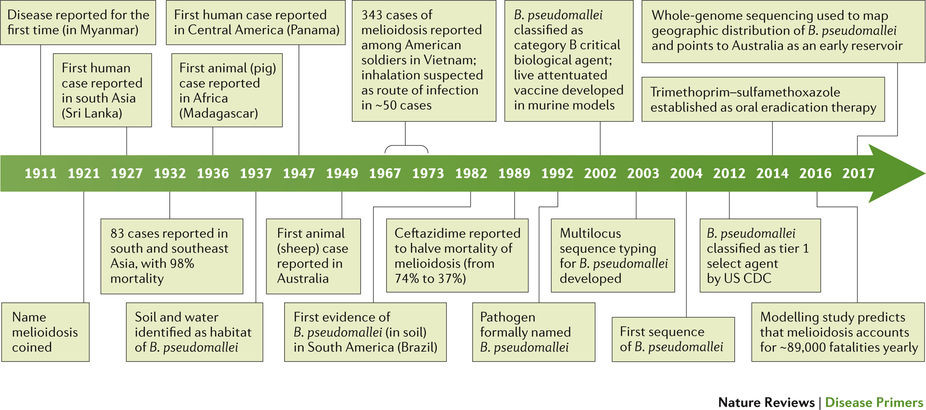類鼻疽
Melioidosis
2018年2月1日 Nature Reviews Disease Primers Article number: 17107 (2018) doi: 10.1038/nrdp.2017.107

類鼻疽は、環境由来グラム陰性菌のBurkholderia pseudomallei による致死的感染症の1つで、毎年世界で約89,000人が死亡すると推定されている。糖尿病は類鼻疽の主要なリスク因子であるが、糖尿病の世界的蔓延によって類鼻疽による死亡者数が増加するとみられている。類鼻疽は、特に東南アジアやオーストラリア北部などの熱帯地域に高頻度に発生する。病原菌であるB. pseudomallei は、その通性細胞内寄生と毒性因子によって、細胞内での生存と持続感染を多種多様な細胞へと拡大していき、宿主の免疫反応とシグナル伝達を操作して体内監視から免れるようになる。そのため、類鼻疽の兆候は幅広く、急性敗血症を呈したり、慢性感染症を呈したりする。大多数の類鼻疽患者で敗血症が見られるが、特徴的臨床症状とその重症度は細菌の侵入経路(経皮吸収、吸入摂取、または経口摂取)、宿主免疫機能、細菌株と細菌負荷に大きく左右される。診断は、細菌培養検査に加えて、臨床症状や疫学的特徴に基づいて行われる。一方、治療では、静脈投与および経口投与によって長期の抗生剤治療が行われる。地域によっては、臨床的認知や検査室診断が難しいことから、治療が遅れるため、予後不良となって死亡率が40%を上回る。B. pseudomallei の生物学的脅威に加え、これを原因とする類鼻疽とその疾患負担の大きさへの認知度が向上したことから、現在、この病原菌の研究が進められている。とりわけ、より早期に発見できる診断検査法を開発して、治療効果と生存率を改善する必要がある。
PrimeView
Burkholderia pseudomallei に感染すると類鼻疽を発症することがある。この疾患は、その兆候の多様さから“the great mimicker(類似した病像が多い疾患)”と呼ばれている。このPrimeViewでは、類鼻疽の発症に関する宿主-病原体相互作用について図説する。
本Primerの図解サマリー
Burkholderia pseudomallei is a Gram-negative environmental bacterium and the aetiological agent of melioidosis, a life-threatening infection that is estimated to account for ∼89,000 deaths per year worldwide. Diabetes mellitus is a major risk factor for melioidosis, and the global diabetes pandemic could increase the number of fatalities caused by melioidosis. Melioidosis is endemic across tropical areas, especially in southeast Asia and northern Australia. Disease manifestations can range from acute septicaemia to chronic infection, as the facultative intracellular lifestyle and virulence factors of B. pseudomallei promote survival and persistence of the pathogen within a broad range of cells, and the bacteria can manipulate the host's immune responses and signalling pathways to escape surveillance. The majority of patients present with sepsis, but specific clinical presentations and their severity vary depending on the route of bacterial entry (skin penetration, inhalation or ingestion), host immune function and bacterial strain and load. Diagnosis is based on clinical and epidemiological features as well as bacterial culture. Treatment requires long-term intravenous and oral antibiotic courses. Delays in treatment due to difficulties in clinical recognition and laboratory diagnosis often lead to poor outcomes and mortality can exceed 40% in some regions. Research into B. pseudomallei is increasing, owing to the biothreat potential of this pathogen and increasing awareness of the disease and its burden; however, better diagnostic tests are needed to improve early confirmation of diagnosis, which would enable better therapeutic efficacy and survival.

